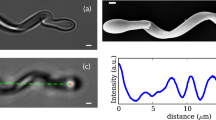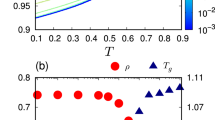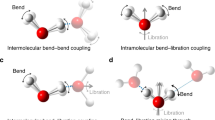Abstract
ALTHOUGH much has been done in an attempt to understand the kinetics of biological processes in terms of their molecular motions1–4, it appears that until now no one has attempted to calculate or measure the proper (normal) modes of motion of helical biological polymers. We think it might help understanding of the mechanism of biological processes (such as the enzyme action of certain proteins or the replication of nucleic acids) if it were possible both to measure and to calculate the proper modes of motion of the polymers themselves since these motions may play an important part in biological processes. This communication presents a very simple calculation of the phonon dispersion of the acoustical modes of the Pauling α-helix in the harmonic approximation. The excitation of the higher (anharmonic) levels of this mode almost certainly leads to the well known helix ⇌ coil transition5.
This is a preview of subscription content, access via your institution
Access options
Subscribe to this journal
Receive 51 print issues and online access
$199.00 per year
only $3.90 per issue
Buy this article
- Purchase on Springer Link
- Instant access to full article PDF
Prices may be subject to local taxes which are calculated during checkout
Similar content being viewed by others
References
Levinthal, C., and Crane, H. R., Proc. U.S. Nat. Acad. Sci., 42, 436 (1956).
Kuhn, N., Experimenta, 13, 301 (1957).
Longuet-Higgins, H. C., and Zimm, B. H., J. Mol. Biol., 2, 1 (1960).
Carothers, D. M., J. Mol. Biol., 9, 712 (1964).
Doty, P., and Yang, J. T., J. Amer. Chem. Soc., 78, 498 (1956).
Chiao, R. Y., and Fluery, P. A., Physics of Quantum Electronics, edit. by Lax, Kelly, and Tannenwald (McGraw-Hill, 1966).
Pauling, L., Corey, R. B., and Branson, H. R., Proc. U.S. Nat. Acad. Sci., 37, 205 (1951).
Kittel, C., Quantum Theory of Solids, chapter 2 (John Wiley and Sons Inc., New York, London, 1963).
Slutsky, L., and Bauer, S. H., J. Amer. Chem. Soc., 76, 270 (1954).
Swalen, J., and Cestain, C. C., J. Chem. Phys., 31, 1562 (1959).
Landau, L., Zwm. Ehsp. Teor. Fiz., 11, 91 (1947).
Feynman, R. P., Prog. Low Temp. Phys., 1, 17 (1955).
Pecora, R., J. Chem. Phys., 43, 1562 (1965).
Cochran, W., Phonons and Phonon Interactions, edit. by Bac, Thor A., 102 (W. A. Benjamin Inc., New York, Amsterdam, 1964).
Brockhouse, B. N., Phonons and Phonon Interactions, edit. by Bac, Thor A.,102 (W. A. Benjamin Inc., New York, Amsterdam, 1964).
Author information
Authors and Affiliations
Rights and permissions
About this article
Cite this article
PETICOLAS, W., DOWLEY, M. Acoustical Phonon Spectra of Biological Polymers. Nature 212, 400–401 (1966). https://doi.org/10.1038/212400a0
Issue Date:
DOI: https://doi.org/10.1038/212400a0
This article is cited by
-
Phonon Spectra of Helical Biopolymers
Nature (1967)
Comments
By submitting a comment you agree to abide by our Terms and Community Guidelines. If you find something abusive or that does not comply with our terms or guidelines please flag it as inappropriate.



